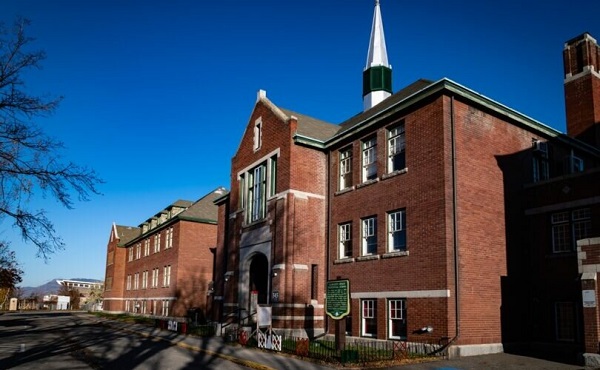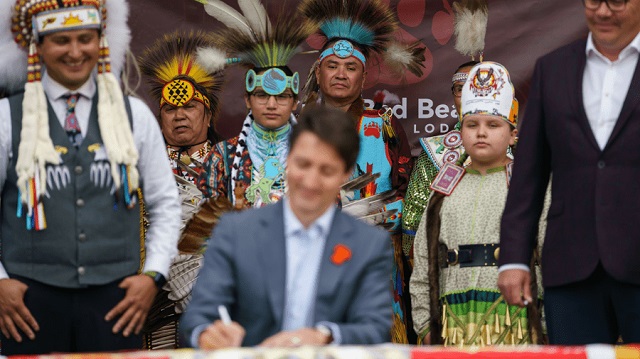Indigenous
Canada’s Indigenous Model is Not Sustainable

From the Frontier Centre for Public Policy
The stated purpose of the extra indigenous spending that has always been there, and the virtual explosion on indigenous spending since 2015 is meant to fix that problem. But these massive expenditures have now reached the point where they risk destabilizing the country.
Canada’s parliamentary budget officer, Yves Giroux has spoken out about the alarming rise in Canada’s contingent liabilities related to indigenous claims. Todays estimated 76 billion dollars is many times the 15 billion dollars it was when the Liberals took power in 2015.
This is one part only of the massive increase in spending on indigenous matters that has taken place since then.
Federal spending per indigenous person has always been much higher than spending per non-indigenous person. The higher level of spending has been justified because most indigenous people do much worse on virtually every health and social indicator than the mainstream population. Their health is poorer, and their lives are shorter.
This disparity was generally known as Canada’s “Indian problem”. That term is no longer fashionable, and the extra spending is now said to be necessary to achieve “reconciliation”. Regardless of the terms, what is clear is that since Confederation there has always existed a large rural and urban indigenous underclass that does poorly compared to the mainstream. The stated purpose of the extra indigenous spending that has always been there, and the virtual explosion on indigenous spending since 2015 is meant to fix that problem. But these massive expenditures have now reached the point where they risk destabilizing the country.
Perhaps it’s time for Canadians to ask if the “nation to nation” reconciliation plan that spending is based on is working. Is it fixing the problem?
A recent CBC report proves that it is not. Instead, the problems are getting worse.
The CBC investigated an indigenous community at St. Theresa Point where 24 people sometime share one house. Almost all of the houses in the community are crumbling and need to be replaced. Families struggle to achieve basic hygiene. Living conditions resemble what one would expect to find in a third world community, and not in wealthy, modern Canada.
St. Theresa Point is typical of hundreds of other Indian remote reserves. Most are almost totally dependent on the federal government for their survival. There is virtually no real employment. The poorest people in those communities are directly dependent on welfare checks, but even the chief, councillors and other employees receive their paycheques from the transfer payments sent by Ottawa. In reality almost everyone in the community is on welfare of some type.
Unlike in other rural communities, people on poor reserves tend not to move when economic opportunities decline. In small-town Canada, the rules are simple: If the towns or farms can’t supply enough jobs, one moves to the city where the jobs and careers are. But on remote reserves, most people stay put, even if there are no jobs or careers there for them. And most of those who do move to the city do not do well. A lack of education, poor job skills, and lack of motivation usually consign reserve residents who move to the mean parts of town where many end up in gangs, crime and prostitution. The result is that the people who stay in uneconomic remote reserves become more and more dependent. Low education levels sink even further. And succeeding generations become ever less likely to be able to provide for themselves and their families.
To make matters much worse, addiction problems are endemic. At one time, alcohol was the drug of choice. Now, amphetamines, fentanyl, and prescription drugs have been added to the list, with the family violence, sexual abuse, crime, teenage pregnancy and fetal alcohol births that inevitably follow from chronic drug use.
And reserve populations are growing. Although status Indians living on reserves currently comprise only about 1% of the total population, they are the country’s fastest growing demographic. The cost of operating these communities is crippling now, but in a few years, it will be completely unsustainable. Pretending that these desperately poor reserves are sovereign “nations” that will somehow magically become prosperous and self-supporting is a cruel joke on the young people hopelessly trapped on them. The prospect of hundreds of dependent reserves teeming with, unemployed, and largely unemployable young people, with massive social problems, is a frightening dystopia – hundreds of Gaza strips. But it is where we are headed. To make things even worse, the government-promoted false genocide and “missing children” narratives have made many of these people very angry.
Although there is no treaty right, or any other right to free housing on a reserve the reality is that if the government did not provide housing for the reserve residents, they would be unable to provide housing for themselves. The strange result is that Canadian taxpayers – many of whom will never be able to afford to buy a house themselves – pay through their tax dollars for houses for the rapidly growing reserve population. These houses deteriorate quickly, because they are considered “free” by the residents, and have to be fixed and replaced in a wasteful and expensive cycle.
And it is a national disgrace that most reserves are dead ends for most of the young people born into them.
The late Farley Mowat described northern indigenous settlements as “unguarded concentration camps”. That might be a somewhat harsh way to describe reserves, but at best most are human warehouses, plagued with social problems. The young people living there deserve some hope, and Canada’s current plan for them offers them none.
So, Canada’s current indigenous plan is clearly not working. Is there a better plan for success?
Maybe we should ask Wab Kinew, Manitoba’s new premier. He is indigenous and highly successful. How did he get there?
The formula is actually not complicated. It has nothing to do with massive welfare giveaways, “nation to nation” utopias, or incredibly expensive “reconciliation” projects. It definitely has nothing to do with staying in a community that lacks economic opportunities, and waiting for handouts. It involves education, hard work, and going where the jobs are. Kinew’s parents realized that a stable home and education were key. Wab did the rest. He worked his way up the ladder in the usual way, and went where the jobs were. He did that with his indigenous identity intact.
Not every young person has Kinew’s talent, but everyone can follow the formula that made Kinew, and many other indigenous achievers successful.
The alternative – spending ever increasing amounts on a steadily increasing list of demands from a growing dependent reserve population is not an option. We don’t need the parliamentary budget officer to tell us that it is not sustainable.
As for remote, uneconomic reserves, like St. Theresa Point, they should be gradually and humanely closed down. It has been recognized for many years that reserves long ago had served their purpose, and should be phased out. As far back as 1911, it was said:
“Department officials were increasingly coming to the view that reserves had outlived their usefulness. Frank Pedley suggested that they resulted in the isolation and segregation of Indians, and thereby hindered progress…and encouraged the tribal form of government.”
The reserve system was not ended in 1911 because the chiefs and ruling families refused to give up their privileged positions. It isn’t happening today for the same reasons. We still have the same Indian Act and reserve system that has held indigenous people back for almost 150 years. (Senior Ontario lawyer, Peter Best, describes the toxicity of the reserve system in his important book, There Is No Difference)
So, the long-term plan should be to find a way to overcome that resistance, and find a fair way to phase out reserves, and the antiquated Indian Act. The reserves that are economically viable can merge into existing rural municipalities, or become stand-alone municipalities. Opportunities should be made available for young people from uneconomic communities to move to job centres, and receive help to succeed there.
In the meantime, the example of Wab Kinew is proof that there has never been a better time or place than today’s Canada to be an educated and ambitious young indigenous person who is willing to study, work hard, and go where the jobs are.
Brian Giesbrecht is a retired judge and senior fellow at Frontier Centre for Public Policy
Watch Brian on Return to Reason here.
Indigenous
Internal emails show Canadian gov’t doubted ‘mass graves’ narrative but went along with it

From LifeSiteNews
Parks Canada employees admitted that ground-penetrating radar results were likely false positives.
Internal emails have revealed that federal workers questioned the residential school narrative as early as 2023, despite gaslighting Canadians who questioned media’s claims.
According to confidential staff emails published by Blacklock’s Reporter on July 4, Parks Canada, the government agency which manages national parks, admitted that claims of hundreds of graves found at an Indian Residential School in Kamloops, British Columbia were unfounded and likely false.
“Authors refer to the 215 ground-penetrating radar hits that were reported in 2021 as ‘graves’ or ‘burials,’” wrote one Parks Canada consultant. “But none of these sites have been investigated further to determine that they are graves.
Like most Canadians, Parks Canada staff initially believed the alleged discovery of 215 so-called “unmarked” graves in Kamloops during the summer of 2021. The story alleged that hundreds of Indigenous children were killed and secretly buried at the residential school.
READ: Canadian councilor punished for denying unproven ‘mass graves’ narrative seeks court review
Canada’s Residential School system was a structure of boarding schools funded by the Canadian government and run by both the Catholic Church and other churches that ran from the late 19th century until the last school closed in 1996.
While some children did tragically die at the once-mandatory boarding schools, evidence has revealed that many of the children passed away as a result of unsanitary conditions due to underfunding by the federal government, not the Catholic Church.
In 2021, Parks Canada hired historians “to help identify any gaps or errors” in the claim of finding 215 unmarked graves before designating the Kamloops Indian Residential School as a historic site.
However, according to their internal emails, Parks Canada discovered that the technology used to discover the “graves” is often misleading and cannot be relied upon.
“Ground-penetrating radar often throws up false positives, anomalies that are not indicative of anything significant,” a consultant wrote. “I suggest that until there is further investigation of the sites at Kamloops the report refer to them as ‘possible graves’ or ‘probable graves’ or ‘likely graves’ rather than ‘graves.’”
As a result, Parks Canada changed their report to list the anomalies as “probable unmarked graves” rather than “unmarked graves.”
“The challenge is that ground-penetrating radar does not provide evidence of potential unmarked graves,” said the staff email. “It provides evidence of anomalies. I am quoting the archaeologists here.”
“Regarding the topic of ground-penetrating radar, I’ve made a suggested revision,” wrote another manager. “It might be preferable to not use the term ‘anomalies’ for now.” Staff were also advised to “stay extra quiet” on the designation of the Residential School as a national historic site.
To date, there have been no mass graves discovered at residential schools. However, following claims blaming the deaths on the Catholic clergy who ran the schools, over 100 churches have been burned or vandalized across Canada in seeming retribution.
READ: Despite claims of 215 ‘unmarked graves,’ no bodies have been found at Canadian residential school
Despite their conclusions, Parks Canada refused to publicly contradict the residential school narrative. On their website discussing the schools, the government agency does not mention the unmarked graves and also fails to debunk the claims of mass unmarked graves.
Furthermore, while the agency internally questioned and doubted the validity of the claims, Canadians who publicly opposed the mainstream narrative were condemned as denialists and often punished.
Despite the lack of physical evidence, in 2022, Canada’s House of Commons under Liberal Prime Minister Justin Trudeau, formalized the controversy and declared the residential school program to be considered a historic act of “genocide.”
Business
Ottawa has spent nearly $18 billion settling Indigenous ‘specific claims’ since 2015

From the Fraser Institute
By Tom Flanagan
Since 2015, the federal government has paid nearly $18 billion settling an increasing number of ‘specific claims’ by First Nations, including more than $7 billion last year alone, finds a new study released today by the Fraser Institute, an independent, non-partisan Canadian public policy think tank.
“Specific claims are for past treaty breaches, and as such, their number should be finite. But instead of declining over time, the number of claims keeps growing as lucrative settlements are reached, which in turn prompts even more claims,” said Tom Flanagan, Fraser Institute senior fellow, professor emeritus of political science at the University of Calgary and author of Specific Claims—an Out-of-Control Program.
The study reveals details about “specific claims,” which began in 1974 and are filed by First Nations who claim that Canadian governments—past or present—violated the Indian Act or historic treaty agreements, such as when governments purchased reserve land for railway lines or hydro projects. Most “specific claims” date back 100 years or more. Specific claims are contrasted with comprehensive claims, which arise from the absence of a treaty.
Crucially, the number of specific claims and the value of the settlement paid out have increased dramatically since 2015.
In 2015/16, 11 ‘specific claims’ were filed with the federal government, and the total value of the settlements was $27 million (in 2024 dollars, to adjust for inflation). The number of claims increased virtually every year since so that by 2024/25, 69 ‘specific claims’ were filed, and the value of the settlements in 2024/25 was $7.061 billion. All told, from 2015/16 to 2024/25, the value of all ‘specific claims’ settlements was $17.9 billion (inflation adjusted).
“First Nations have had 50 years to study their history, looking for violations of treaty and legislation. That is more than enough time for the discovery of legitimate grievances,” Flanagan said.
“Ottawa should set a deadline for filing specific claims so that the government and First Nations leaders can focus instead on programs that would do more to improve the living standards and prosperity for both current and future Indigenous peoples.”

Specific Claims: An Out-of-Control Program
- Specific claims are based on the government’s alleged failure to abide by provisions of the Indian Act or a treaty.
- The federal government began to entertain such claims in 1974. The number and value of claims increased gradually until 2017, when both started to rise at an extraordinary rate.
- In fiscal year 2024/25, the government settled 69 claims for an astonishing total of $7.1 billion dollars.
- The evidence suggests at least two causes for this sudden acceleration. One was the new approach of Justin Trudeau’s Liberal government toward settling Indigenous claims, an approach adopted in 2015 and formalized by Minister of Justice Jodi Wilson-Raybould’s 2019 practice directive. Under the new policy, the Department of Justice was instructed to negotiate rather than litigate claims.
- Another factor was the recognition, beginning around 2017, of “cows and plows” claims based on the allegation that agricultural assistance promised in early treaties—seed grain, cattle, agricultural implements—never arrived or was of poor quality.
- The specific-claims process should be terminated. Fifty years is long enough to discover legitimate grievances.
- The government should announce a short but reasonable period, say three years, for new claims to be submitted. Claims that have already been submitted should be processed, but with more rigorous instructions to the Department of Justice for legal scrutiny.
- The government should also require more transparency about what happens to these settlements. At present, much of the revenue paid out disappears into First Nations’ “settlement trusts”, for which there is no public disclosure.
-

 Bruce Dowbiggin2 days ago
Bruce Dowbiggin2 days agoThe Covid 19 Disaster: When Do We Get The Apologies?
-

 Crime1 day ago
Crime1 day agoSweeping Boston Indictment Points to Vast Chinese Narco-Smuggling and Illegal Alien Labor Plot via Mexican Border
-

 Alberta2 days ago
Alberta2 days agoAlberta school boards required to meet new standards for school library materials with regard to sexual content
-

 International20 hours ago
International20 hours agoSupport for the Ukraine war continues because no one elected is actually in charge.
-

 Business20 hours ago
Business20 hours agoTrump slaps Brazil with tariffs over social media censorship
-

 Environment1 day ago
Environment1 day agoEPA releases report on chemtrails, climate manipulation
-

 Business23 hours ago
Business23 hours agoCBC six-figure salaries soar
-

 Addictions22 hours ago
Addictions22 hours agoCan addiction be predicted—and prevented?




